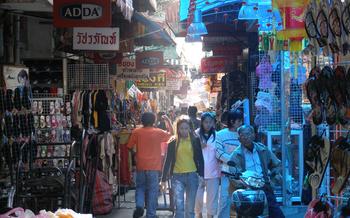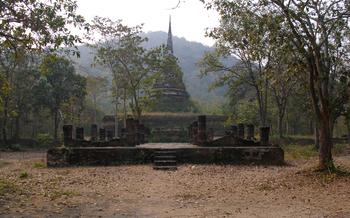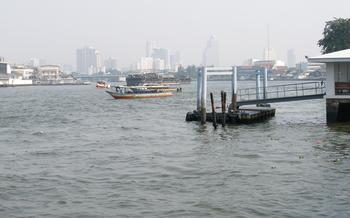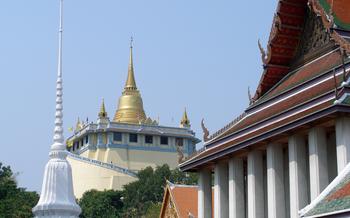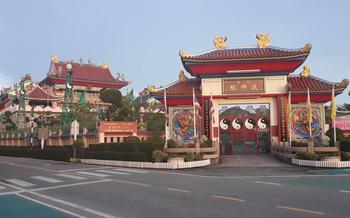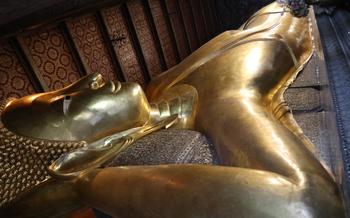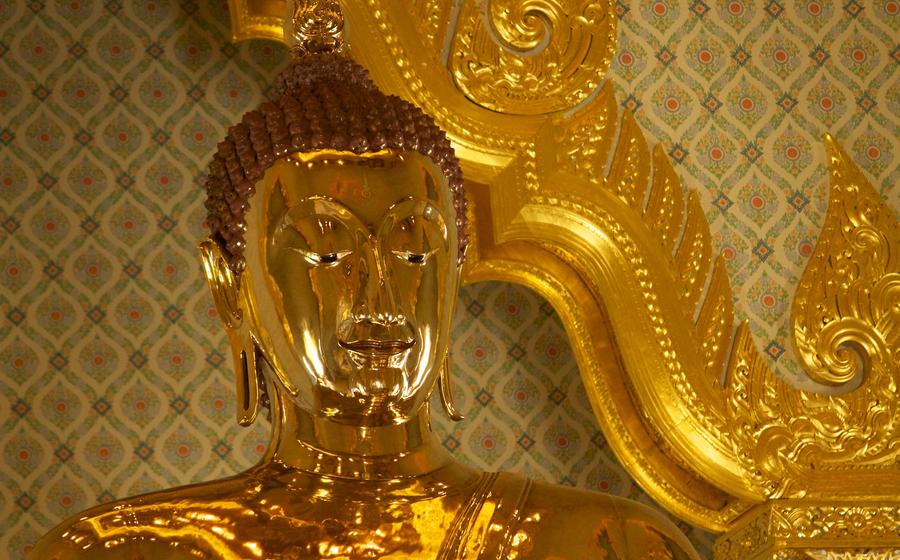
The Golden Buddha at Wat Traimit
- The Golden Buddha at Wat Traimit: A Brief Introduction
- The Making of a Majestic Icon: The Story Behind the Golden Buddha
- The Discovery of a Hidden Treasure: How the Golden Buddha Was Found
- Wat Traimit: A Haven of Tranquility Amidst the Bustle of Bangkok
- The Golden Buddha Festival: A Time for Celebration and Reflection
- Exploring the Golden Buddha's Surroundings: Nearby Attractions
- Unveiling the Secrets of the Golden Buddha's Composition
- The Golden Buddha's Cultural Influence: Art, Literature, and More
- Experiencing the Golden Buddha: Tips for Visitors
- The Golden Buddha's Economic Impact: Tourism and Beyond
- Preserving the Golden Buddha: Conservation and Restoration Efforts
- The Golden Buddha's Global Significance: A Symbol of Peace and Unity
- Local Perspectives and Stories: The Golden Buddha Through Thai Eyes
- Insider Tip: Unveiling the Hidden Gems of Wat Traimit
The Golden Buddha at Wat Traimit: A Brief Introduction
Majestically enshrined within the temple walls of Wat Traimit lies the Golden Buddha, an iconic symbol of Thailand's rich cultural heritage. Cast in solid gold, this awe-inspiring statue is not just a work of art but holds profound historical and religious significance. Its journey through the centuries has been marked by intriguing legends and fascinating events, making it a must-see attraction for travelers and pilgrims alike.
Nestled in the heart of Bangkok's vibrant Chinatown district, Wat Traimit offers a sanctuary of peace amidst the bustling city. Easily accessible by public transportation, the temple welcomes visitors from all corners of the globe to marvel at the Golden Buddha's splendor. As you step through the temple gates, prepare to be captivated by the radiant aura that emanates from this magnificent creation.
Surrounding the Golden Buddha are numerous tales and legends, each adding to its mystique. Some believe it to be a relic from the ancient Kingdom of Sukhothai, while others whisper of its miraculous journey across the sea, hidden within a layer of stucco to protect it from invaders. These captivating stories have woven themselves into the fabric of Thai history and folklore, further enhancing the statue's allure.
The Making of a Majestic Icon: The Story Behind the Golden Buddha
The Golden Buddha at Wat Traimit is not just a revered religious icon; it also holds a rich and intriguing history. The origins of the Buddha statue are shrouded in mystery and legend, adding to its allure and significance. According to one account, the statue was crafted in the 13th century during the Sukhothai period, a golden era of Thai art and culture. Skilled artisans meticulously shaped the massive statue using a unique casting technique, resulting in its exceptional beauty and intricate details.
Another legend suggests that the Golden Buddha was created even earlier, during the reign of King Rama I, the founder of the Chakri dynasty. It is said that the king commissioned the statue to be cast from gold and hidden within a layer of stucco to protect it from invading Burmese armies. The statue remained concealed for centuries, its true value and splendor unknown until its rediscovery in the 20th century.
The Golden Buddha's unique features and artistic significance set it apart from other Buddha statues. Its massive size, weighing over five tons, and its solid gold composition make it a truly awe-inspiring sight. The statue exudes an aura of serenity and compassion, with its serene facial expression and graceful posture. The intricate details and ornamentation on the Buddha's robe and headdress showcase the exceptional craftsmanship of its creators.
The Discovery of a Hidden Treasure: How the Golden Buddha Was Found
Buried beneath layers of plaster and stucco for centuries, the Golden Buddha remained hidden from the world. Its rediscovery in 1955 was a remarkable tale of serendipity and chance. During a routine renovation of Wat Traimit, a crane accidentally knocked into the Buddha statue, causing the plaster shell to crack and reveal the gleaming gold beneath.
The temple's abbot, upon witnessing the golden glow, immediately recognized the statue's significance. He ordered the removal of the remaining plaster, revealing a magnificent Buddha statue of solid gold. The news of this extraordinary find spread like wildfire, captivating the nation and attracting international attention.
The discovery of the Golden Buddha was a pivotal moment in Thai history. It sparked renewed interest in the country's cultural heritage and led to a surge in tourism. The statue's rediscovery also ignited a debate about the origins and history of the Buddha, with scholars and historians delving into its past to uncover its secrets.
Wat Traimit: A Haven of Tranquility Amidst the Bustle of Bangkok
In the heart of Bangkok's vibrant Chinatown district, nestled amidst bustling markets and narrow streets, lies Wat Traimit, a temple of immense historical, cultural, and spiritual significance. Founded in the 13th century, this ancient temple is home to the awe-inspiring Golden Buddha, attracting millions of devotees and tourists from around the world.
Wat Traimit's architectural beauty is a testament to Thailand's rich artistic heritage. The intricate carvings adorning the temple's exterior depict scenes from Buddhist mythology and showcase the exceptional craftsmanship of Thai artisans. The temple's interior exudes a serene and spiritual ambiance, inviting visitors to find solace and tranquility amidst the bustling city.
As a significant center of Thai Buddhism, Wat Traimit holds a sacred place in the hearts of the Thai people. Locals visit the temple to pay homage to the Golden Buddha, seek blessings, and offer prayers for good fortune and prosperity. The temple's serene atmosphere fosters a sense of devotion and spirituality, making it a refuge for those seeking inner peace and spiritual connection.
The temple grounds offer a tranquil oasis amidst the chaotic energy of Bangkok. Visitors can stroll through the lush gardens, admire the intricate murals depicting Buddhist teachings, and find respite from the bustling city life. Wat Traimit is a sanctuary of peace and tranquility, where visitors can immerse themselves in the spirituality and serenity of Thai Buddhism.
The Golden Buddha Festival: A Time for Celebration and Reflection
Every year, during the fifth lunar month of the Thai calendar, Wat Traimit hosts the Golden Buddha Festival, a grand celebration that attracts thousands of devotees and visitors from around the world. The festival is a time to honor and pay homage to the sacred Golden Buddha and to celebrate its discovery and significance.
During the festival, the temple is adorned with colorful decorations, and the air is filled with the sounds of chanting monks, traditional music, and the laughter of children. Devotees offer prayers and make offerings to the Golden Buddha, seeking blessings and good fortune.
The festival also features a variety of cultural performances and activities, including traditional Thai dance, music, and martial arts demonstrations. Visitors can enjoy delicious Thai food from street vendors and shop for souvenirs at the many stalls set up around the temple grounds.
The Golden Buddha Festival is a vibrant and joyous occasion that offers a glimpse into Thai culture and traditions. It is a time for reflection and spiritual renewal, and a wonderful opportunity to experience the beauty and serenity of Wat Traimit.
Exploring the Golden Buddha's Surroundings: Nearby Attractions
Wat Traimit's neighborhood is a treasure trove of cultural and historical wonders, beckoning visitors to delve deeper into Bangkok's rich tapestry.
A short walk from the temple, Chinatown, Bangkok's vibrant and bustling enclave, awaits exploration. With its labyrinthine alleys lined with colorful shophouses, the district is a shopper's paradise, offering an array of souvenirs, trinkets, and culinary delights. From traditional Chinese tea shops to bustling street food stalls, Chinatown tantalizes the senses with its unique blend of sights, sounds, and aromas.
The Chao Phraya River, Bangkok's majestic waterway, flows gracefully nearby, offering a scenic and tranquil escape from the city's hustle and bustle. Hop aboard one of the many express boats or traditional long-tail boats and embark on a leisurely cruise along the river, passing by iconic landmarks such as the Grand Palace, Wat Pho, and Wat Arun. The riverfront is also lined with charming cafes, restaurants, and bars, providing opportunities to soak in the stunning views while savoring delicious local cuisine.
Other temples and historical sites in the vicinity further enrich the cultural experience. Wat Mangkon Kamalawat, a prominent Chinese Buddhist temple, boasts intricate architecture and a vibrant atmosphere, while Wat Kalayanamitr, a royal temple known for its beautiful murals, offers a glimpse into Thailand's rich artistic heritage. The nearby Pak Khlong Talat, Bangkok's renowned flower market, paints a vibrant picture with its kaleidoscope of colors and fragrant blossoms.
Exploring the surroundings of the Golden Buddha at Wat Traimit unveils a captivating tapestry of cultural, historical, and natural wonders, ensuring a truly immersive and unforgettable experience in Bangkok.
Unveiling the Secrets of the Golden Buddha's Composition
The Golden Buddha is not just a religious icon but also a metallurgical marvel. Its unique alloy composition has been the subject of scientific curiosity and analysis. Unlike most Buddha statues made of bronze or brass, the Golden Buddha is primarily composed of an alloy of gold, silver, and copper. The exact proportions of these metals remain a mystery, adding to the statue's allure.
Scientific studies conducted on the statue have revealed the presence of trace elements, such as lead, zinc, and iron, suggesting that the alloy was likely derived from recycled materials. This discovery aligns with the theory that the statue was cast using melted-down jewelry and other gold objects donated by devotees.
The unique composition of the alloy has contributed to the statue's remarkable durability and resistance to corrosion. Despite its age, the Golden Buddha retains its original luster and golden hue, testament to the skill and craftsmanship of its ancient creators.
The Golden Buddha's Cultural Influence: Art, Literature, and More
The Golden Buddha's influence extends far beyond the confines of Wat Traimit. It has become an iconic symbol deeply embedded in Thai art, literature, and cultural identity.
In Thai art, the Golden Buddha is a recurring motif, depicted in various forms and styles. Paintings, sculptures, and other artworks showcase the Buddha's serene presence, often adorned with intricate details and symbolic elements. These artistic representations not only pay homage to the Buddha but also reflect the deep reverence and admiration held by Thai people.
In Thai literature, the Golden Buddha features prominently in folktales, legends, and historical accounts. These stories often weave together myth, history, and cultural beliefs, portraying the Buddha as a source of inspiration, guidance, and protection. The Golden Buddha's presence in Thai literature reinforces its significance as a symbol of national pride and cultural heritage.
Beyond Thailand, the Golden Buddha has gained global recognition and appreciation. Its unique beauty and historical importance have captivated people worldwide, making it a symbol of peace, harmony, and compassion. The statue's presence in international exhibitions and museums has further solidified its status as a cultural treasure of global significance.
The Golden Buddha's influence is a testament to its enduring power to inspire, unite, and represent the essence of Thai culture. It stands as a symbol of Thailand's rich artistic traditions, deep-rooted Buddhist beliefs, and cultural pride, resonating with people from all walks of life.
Experiencing the Golden Buddha: Tips for Visitors
To fully appreciate the majesty of the Golden Buddha, it is essential to plan your visit carefully. Here are a few tips to make your experience both serene and enriching:
-
Recommended time to visit: Aim to visit the temple early in the morning or late in the afternoon to avoid the midday crowds and enjoy a more tranquil atmosphere.
-
Dress code and attire: When visiting Wat Traimit, it is important to dress respectfully. Avoid shorts, tank tops, and revealing clothing. Opt for lightweight, loose-fitting attire that covers your shoulders and knees.
-
Photography guidelines: Photography is permitted within the temple, but visitors are kindly requested to be mindful of other worshippers and maintain a respectful demeanor. Flash photography and tripods are not allowed.
The Golden Buddha's Economic Impact: Tourism and Beyond
The Golden Buddha at Wat Traimit has played a pivotal role in the tourism industry of Thailand. The temple attracts millions of visitors each year, both domestic and international, who come to pay homage to the revered Buddha statue and marvel at its splendor. This influx of tourists has generated significant economic benefits for the country.
The temple's proximity to Chinatown, one of Bangkok's most popular tourist destinations, further enhances its economic importance. Many visitors combine a visit to Wat Traimit with exploring the vibrant markets, shops, and restaurants of Chinatown, creating a synergistic relationship that benefits both attractions.
Beyond direct tourism revenue, the Golden Buddha has also indirectly contributed to the growth of related industries such as transportation, hospitality, and souvenirs. The presence of such a significant cultural and religious landmark has helped to position Thailand as a must-visit destination for travelers worldwide, contributing to the country's overall economic development.
Recognizing the importance of sustainable tourism, the temple authorities have implemented various initiatives to ensure that the benefits of tourism are shared equitably and that the environment is protected. These efforts include promoting responsible tourism practices, investing in infrastructure development, and supporting local communities through tourism-related employment opportunities.
Preserving the Golden Buddha: Conservation and Restoration Efforts
The Golden Buddha has stood the test of time, yet it requires meticulous care and conservation efforts to ensure its longevity. Over the years, several projects have been undertaken to preserve and restore this national treasure. In the 1950s, the statue underwent a significant restoration process, which involved cleaning, polishing, and repairing minor damages. This restoration aimed to remove impurities and enhance the Buddha's radiant golden appearance.
In recent years, advanced scientific techniques have been employed to study and conserve the Golden Buddha. Non-invasive methods, such as X-ray and ultrasound imaging, have been used to assess the statue's internal structure and identify any potential weaknesses or areas of concern. Based on these findings, targeted conservation measures can be implemented to address specific issues.
Preserving the Golden Buddha poses unique challenges due to its immense size, weight, and the delicate nature of its materials. Specialized equipment and expertise are required to handle and maintain such a massive artifact safely. The temple authorities work closely with conservators and scientists to develop sustainable conservation strategies that balance the need for preservation with the desire to maintain the statue's original appearance and spiritual significance.
The Golden Buddha's Global Significance: A Symbol of Peace and Unity
The Golden Buddha, with its aura of tranquility and benevolence, transcends geographical boundaries to become a universal symbol of peace, harmony, and compassion. It embodies the teachings of Lord Buddha, emphasizing the importance of love, kindness, and understanding among all beings. The statue's serene countenance and gentle smile serve as a reminder to people of all faiths and backgrounds to embrace compassion and work towards creating a more harmonious world.
Moreover, the Golden Buddha has played a significant role in promoting interfaith dialogue and understanding. It has become a bridge that connects people from diverse religious traditions, fostering a spirit of tolerance and respect. The statue's universal appeal has facilitated conversations about shared values, commonalities, and the importance of learning from one another.
It is also a symbol of unity, bringing people together from all corners of the globe. Regardless of race, religion, or nationality, the Golden Buddha inspires a sense of oneness and interconnectedness. It serves as a reminder that despite our differences, we are all part of the human family and that together we can create a more peaceful and harmonious world.
Local Perspectives and Stories: The Golden Buddha Through Thai Eyes
The Golden Buddha holds a special place in the hearts and minds of the Thai people. Locals have a deep reverence for the statue and often share heartwarming stories and anecdotes about its significance.
One local resident, Khun Yai, fondly recalls her childhood memories of visiting Wat Traimit with her family. She remembers being in awe of the Buddha's majestic presence and the spiritual energy that permeated the temple grounds. "I felt a sense of peace and tranquility every time I visited," she says.
Another local, Khun Chai, shares a story about how the Golden Buddha played a role in his personal journey. He explains that during a difficult time in his life, he sought solace in the temple and found comfort in the Buddha's serene presence. "I prayed to the Buddha for guidance and strength, and I believe that his blessings helped me overcome my challenges," he says.
These personal stories and experiences highlight the profound impact that the Golden Buddha has on the lives of the Thai people. The statue is not just a national treasure but also a symbol of hope, faith, and resilience for many individuals.
Insider Tip: Unveiling the Hidden Gems of Wat Traimit
Beyond the awe-inspiring Golden Buddha, Wat Traimit holds a treasure trove of hidden gems waiting to be discovered. One such gem is the intricate mural depicting the life of Buddha, adorning the walls of the main prayer hall. Each stroke of the mural narrates a chapter from the Buddha's journey, immersing visitors in his teachings and enlightenment.
Explore the temple's serene gardens, where ancient trees stand as silent witnesses to time, providing respite from the city's hustle and bustle. Discover the intricate carvings adorning the temple's pillars, each a masterpiece of craftsmanship, whispering tales of Thailand's rich history and cultural heritage.
For those seeking a deeper spiritual connection, venture into the meditation hall, where the air is infused with tranquility and the sound of gentle chanting. Join the monks in their daily meditation practice, finding inner peace and harmony amidst the sacred ambiance of the temple.
As you wander through Wat Traimit, allow yourself to be captivated by its hidden treasures, where every nook and corner reveals a new story, a new insight into Thai culture and spirituality. Embrace the opportunity to experience the temple's lesser-known wonders, creating memories that will last a lifetime.
